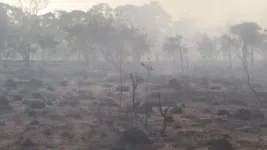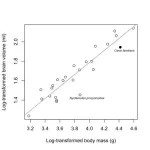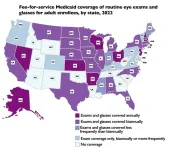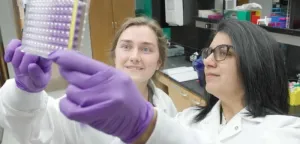(Press-News.org) For thousands of years, plants have evolved in the presence of wildfires in the Cerrado, Brazil’s savanna-like biome. Scientists at São Paulo State University (UNESP) studied the effect of smoke on seed germination for 44 plant species typical of the Cerrado, as reported in an article published in Plant Ecology, where they stress that their findings could be used to optimize the restoration of degraded areas.
The study was conducted by PhD candidate Gabriel Schmidt Teixeira Motta under the supervision of Rosana Marta Kolb, a professor at UNESP.
“Previous studies focused on the effect of smoke on only a few species. This one is the most comprehensive analysis of the kind regarding the Cerrado. Gabriel investigated the effect of smoke on germination for 44 species in the herbaceous-shrub stratum, involving grasses, forbs [herbaceous plants other than grasses], subshrubs and shrubs,” Kolb said.
Smoke contains hundreds of substances, some of which help germination while others hinder it, depending on the species. The most well-known are karrikins – germination and growth regulators found in the smoke of burning plant material. Karrikins interact with the plants’ hormones, promoting germination of certain seeds and inhibiting the development of others.
“Research using gaseous smoke involves variables that are hard to replicate, so instead we used ‘smoke water’, which can be bought off the shelf. It produces an effect equivalent to that of rain after a bushfire, and its action can easily be reproduced by other researchers,” Kolb explained, adding that the smoke-water concentrations used in her laboratory were 2.5% and 5.0%.
Practical applications
The study focused on the individual effects of these two concentrations of smoke water on the germination of the 44 species without taking into account the influence of management strategies. Nevertheless, the practical applications are obvious: seeds that respond well can be sown in areas that have undergone the action of fire or areas degraded by livestock raising and other uses that have been previously treated with smoke water in the right concentration. “Our conclusion was that not just plants typical of savannas but also some wetland species that haven’t evolved in the presence of frequent intense fire will respond well to treatment with smoke,” Kolb said.
Germination increased in response to smoke in 14 of the 44 species studied (32%), with variations depending on the concentration. On the other hand, germination decreased significantly in four species (9%), especially at the higher concentration (5%). Grasses germinated faster in response to smoke, particularly Ctenium polystachyum and Saccharum villosum, which displayed a substantial reduction in average germination time after treatment with smoke water.
“The results show that smoke can act as a strong stimulant of germination in some Cerrado species, offering a competitive advantage in the post-fire environment. The study suggests that responses to smoke are highly specific to each species and vary in accordance with the form of growth and the type of plant community,” Kolb said.
Besides Motta and Kolb, Natashi Pilon and Alessandra Fidelis participated in the study, which was supported by FAPESP via the project “Fire-adapted seed traits in Cerrado species”, for which Fidelis was principal investigator, and a postdoctoral scholarship awarded to Pilon.
About São Paulo Research Foundation (FAPESP)
The São Paulo Research Foundation (FAPESP) is a public institution with the mission of supporting scientific research in all fields of knowledge by awarding scholarships, fellowships and grants to investigators linked with higher education and research institutions in the State of São Paulo, Brazil. FAPESP is aware that the very best research can only be done by working with the best researchers internationally. Therefore, it has established partnerships with funding agencies, higher education, private companies, and research organizations in other countries known for the quality of their research and has been encouraging scientists funded by its grants to further develop their international collaboration. You can learn more about FAPESP at www.fapesp.br/en and visit FAPESP news agency at www.agencia.fapesp.br/en to keep updated with the latest scientific breakthroughs FAPESP helps achieve through its many programs, awards and research centers. You may also subscribe to FAPESP news agency at http://agencia.fapesp.br/subscribe.
END
Treatment with smoke can favor seed germination in the Cerrado
The study investigated the effect of two concentrations of smoke on seeds of 44 species typical of the Brazilian savanna-like biome. The results could be used in management and restoration strategies.
2024-08-06
ELSE PRESS RELEASES FROM THIS DATE:
Medicaid vision coverage for adults varies widely by state
2024-08-06
A study supported by the National Institutes of Health (NIH) shows that 6.5 million Medicaid enrollees (12%) lived in states without coverage for routine adult eye exams; and 14.6 million (27%) resided in states without coverage for eyeglasses. The study based on 2022-23 coverage policies, published in Health Affairs, is among the first to provide a comprehensive, state-by-state analysis of adult Medicaid benefits for basic vision services in both fee-for-service and managed care.
Medicaid provides health coverage to millions of Americans, including eligible low-income adults, children, pregnant women, elderly ...
Chemical and nutritional profile of fruit, vegetables and co-produts to improve human health
2024-08-06
A new study emphasizes the vital role of fruits, vegetables, and their co-products in boosting human health and life expectancy. Packed with minerals, vitamins, and dietary fiber, these foods help prevent chronic diseases. Antioxidants in fruits and vegetables, such as vitamins and carotenoids, combat harmful free radicals.
Interested in more information and in contributing to the topic, visit: bit.ly/46zTKFX
Combining various fruits like oranges, apples, grapes, and blueberries enhances antioxidant effects. Diets rich in these foods can lower blood pressure, reduce heart disease and ...
Better cancer trial representation begins with speaking one’s language
2024-08-06
NEW YORK, NY (July 29, 2024) ---- Underrepresentation of racial and ethnic minority populations in cancer clinical trials persists partly because translation and interpretation services and resources are unavailable or inadequate in the United States, according to a Children’s Oncology Group (COG) study led by Columbia University School of Nursing. The updated study was published online in the Journal of the National Cancer Institute Cancer Spectrum on July 25, 2024 and will appear in the August 2024 journal issue.
In 2019, 68 million people in the United States were reported to speak a language other than ...
Social and structural factors are key drivers of disparities in obesity rates
2024-08-06
Obesity is an epidemic in the United States. It has been increasing among adults of all races and ethnicities over the last two decades; however, obesity is higher among Non-Hispanic Black adults, Hispanic adults, and American Indian or Alaska Native adults, than their White and Asian counterparts, according to the National Institutes of Health. Adults with lower income also have higher risk of obesity than those with a high income.
A George Mason University College of Public Health team of interprofessional researchers analyzed the last five years ...
New study helps global MNCs weigh the pros and cons of implementing blockchain technology
2024-08-06
Blockchain technology has become one of the most hyped advancements in recent years, but there hasn’t been a clear understanding of the potential trade-offs for its use by multinational corporations (MNCs). A new study published in the Global Strategy Journal provides a better understanding of blockchain merits and drawbacks by focusing on three particular applications of the technology in this sector: financial transactions, collaboration, and data analytics.
The study, “A perspective on three trade-offs of blockchain technology for the global strategy of the MNC,” was authored by Tuuli Hakkarainen of the University of Liverpool, Anatoli Colicev of the University ...
Increased ventilation not effective in reducing influenza virus spread in play-based model, Emory study finds
2024-08-06
Increasing ventilation in child-care settings may not always be effective at preventing flu virus spread, according to a new study published by a team of researchers at Emory University, University of Pittsburgh School of Medicine, and Virginia Tech.
The spread of flu viruses is commonly studied in animal models that don’t mimic the real-life scenarios of the human experience, making it difficult to evaluate strategies that will be effective in common places where disease spreads rapidly, such as childcare settings. As reported online and in a coming print issue of the journal Proceedings of the National ...
Lonely people tend to have more nightmares, Oregon State University research shows
2024-08-06
CORVALLIS, Ore. – People who are lonely are more apt to have bad dreams, according to a collaboration that included an Oregon State University scientist.
The findings are important because both loneliness and sleep disorders are serious public health issues, said OSU’s Colin Hesse. They are connected to increased risk of heart disease, stroke and premature death.
In a paper published in the Journal of Psychology, Hesse and researchers at the University of Arizona, the University of Tampa and Whitworth University note that stress ...
UC Irvine-led team reveals how TREM2 genetic mutation affects late-onset Alzheimer’s
2024-08-06
Irvine, Calif., Aug. 6, 2024 — Researchers led by the University of California, Irvine have discovered how the TREM2 R47H genetic mutation causes certain brain areas to develop abnormal protein clumps, called beta-amyloid plaques, associated with late-onset Alzheimer’s disease. Leveraging single-cell Merfish spatial transcriptomics technology, the team was able to profile the effects of the mutation across multiple cortical and subcortical brain regions, offering first-of-their-kind insights at the single-cell level.
The study, recently published online in the journal Molecular Psychiatry, compared the brains of normal mice and special mouse models that undergo ...
Considering the patient’s perspective in inducible laryngeal obstruction care
2024-08-06
Inducible laryngeal obstruction is a breathing disorder characterized by unwanted vocal fold closure having the potential to restrict breathing at times.
It’s estimated that between 3-12% of patients with dyspnea complaints have inducible laryngeal obstruction.
Patients with inducible laryngeal obstruction are thought to make up to 22% of patients with frequent emergency room visits due to sudden onset dyspnea.
While experts know how to treat the condition, there’s not much formal research about what patients with the disorder experience ...
Living with a killer: How an unlikely mantis shrimp-clam association violates a biological principle
2024-08-06
Media
When clams gamble on living with a killer, sometimes their luck may run out, according to a University of Michigan study.
A longstanding question in ecology asks how can so many different species co-occur, or live together, at the same time and at the same place. One influential theory called the competitive exclusion principle suggests that only one species can occupy a particular niche in a biological community at any one time.
But out in the wild, researchers find many instances of different species that appear to occupy the same ...
LAST 30 PRESS RELEASES:
Electrons lag behind the nucleus
From fungi to brain cells: one scientist's winding path reveals how epigenomics shapes neural destiny
Schizophrenia and osteoporosis share 195 genetic loci, highlighting unexpected biological bridges between brain and bone
Schizophrenia-linked genetic variant renders key brain receptor completely unresponsive to both natural and therapeutic compounds
Innovative review reveals overlooked complexity in cellular energy sensor's dual roles in Alzheimer's disease
Autism research reframed: Why heterogeneity is the data, not the noise
Brazil's genetic treasure trove: supercentenarians reveal secrets of extreme human longevity
The (metabolic) cost of life
CFRI special issue call for papers: New Frontiers in Sustainable Finance
HKU Engineering scholar demonstrates the smallest all-printed infrared photodetectors to date
Precision empowerment for brain "eavesdropping": CAS team develops triple-electrode integrated functional electrode for simultaneous monitoring of neural signals and chemical transmitters during sleep
Single-capillary endothelial dysfunction resolved by optoacoustic mesoscopy
HKU three research projects named among ‘Top 10 Innovation & Technology News in Hong Kong 2025’ showcasing excellence in research and technology transfer
NLRSeek: A reannotation-based pipeline for mining missing NLR genes in sequenced genomes
A strand and whole genome duplication–aware collinear gene identification tool
Light storage in light cages: A revolutionary approach to on-chip quantum memories
Point spread function decoupling in computational fluorescence microscopy
BacPhase: Long-insert paired-end sequencing for bin marker construction and genome phasing
GmWOX1 regulates the mediolateral polarity of compound leaves in soybean
ChargeFabrica: An open-source simulation tool that aims to accelerate search for high performance perovskite solar cells
High levels of ADAR overexpression induce abundant and stochastic off-target RNA editing in rice protoplasts
On-demand upgraded recycling of polyethylene and construction of sustainable multifunctional materials based on the "LEGO" strategy
New "Stomata in-sight" system allows scientists to watch plants breathe in real-time
Anorexia nervosa may result in long-term skeletal muscle impairment
Narrative-based performance reviews deemed fairest by employees
New insights reveal how advanced oxidation can tackle emerging water pollutants
New review shows how biomass can deliver low-carbon gaseous fuels at scale
Climate change is quietly rewriting the world’s nitrogen cycle, with high stakes for food and the environment
Study finds SGLT-2 inhibitors linked to lower risk of diabetic foot nerve damage
Microbes may hold the key to brain evolution
[Press-News.org] Treatment with smoke can favor seed germination in the CerradoThe study investigated the effect of two concentrations of smoke on seeds of 44 species typical of the Brazilian savanna-like biome. The results could be used in management and restoration strategies.




